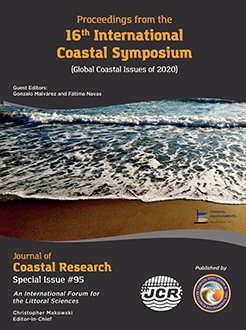Cabezas-Rabadán, C.; Pardo-Pascual, J.E.; Palomar-Vázquez, J.; Ferreira, Ó., and Costas, S., 2020. Satellite Derived Shorelines at an exposed meso-tidal beach. In: Malvárez, G. and Navas, F. (eds.), Global Coastal Issues of 2020. Journal of Coastal Research, Special Issue No. 95, pp. 1027–1031. Coconut Creek (Florida), ISSN 0749-0208.
Shoreline position data offer extremely valuable information for understanding coastal dynamism and beach changes. This research applies SHOREX system for defining the shoreline position from free mid-resolution Landsat-8 (L8) and Sentinel-2 (S2) satellite imagery. This system allows an automatic definition of Satellite Derived Shorelines (SDS) over large regions and periods. Accuracy and utility of the resulting SDS have been previously assessed with positive results at low energy, microtidal, Mediterranean beaches. This work assesses SDS extracted using SHOREX at a mesotidal and moderate to highly (during storms) energetic environment, namely at Faro Beach, a barrier beach located in Ria Formosa (Algarve, South Portugal). Accuracy was defined for 14 SDS derived from S2 and 10 from L8 by measuring the differences in position with respect to the shoreline inferred from profiles obtained on close dates (or simultaneously) to imagery acquisition. For non-simultaneous datasets, the water level was estimated for the time of the satellite images acquisition using oceanographic data and run-up formulations. The measured and estimated shoreline positions were then compared with the extracted SDS. The overall accuracy is good, with errors about 5 m RMSE, supporting the application of the used methodology to define shoreline dynamics and evolution at challenging environments, as mesotidal exposed and dynamic beaches.





